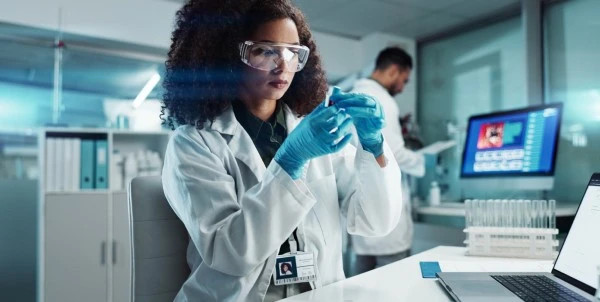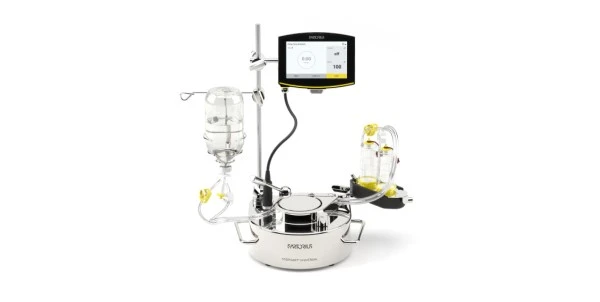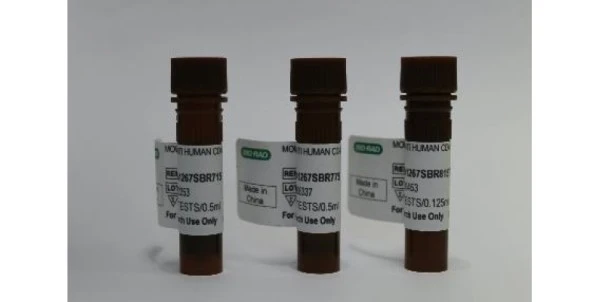Reasons to Upgrade your Gas Chromatograph (GC) – a new series about lab instruments with significant technological advances that provide compelling reasons to upgrade from your current make and model.
Product: Intuvo 9000 Gas Chromatograph.
Company: Agilent Technologies Inc.
Compatibility: Agilent MS Systems.
LabX.com recently conducted a phone interview with Eric Denoyer, Ph.D., Director of Marketing, GC & Workflow Automation at Agilent Technologies, Inc. about the Intuvo 9000 GC System. Dr. Denoyer has many years’ experience operating analytical systems in lab settings.
Gas chromatography has been used for about 50 years as a separation and analytic technique. It is now frequently coupled to mass spectrometry to extend the limits of analyte detection and identification. Gas chromatography is considered a ‘mature’ technique, and was expected to continue advancing in small increments. However, when the GC development team at Agilent Technologies, Inc. unveiled its newest product, the Intuvo 9000 Gas Chromatograph, in early September, 2016, LabX.com was impressed with the fact this GC incorporates not one, but three new transformative technologies. In our opinion, each of these innovations is a significant advance; however, the three new technologies combined provide an especially powerful incentive to upgrade from your current GC or GC-MS system.
Here are the three new hardware features in the Intuvo 9000:
Direct conductive heating of the planar columns – the capillary filament of the column is carefully coiled into a planar configuration. Heating is achieved by direct contact between a heated disk that folds up along a hinge and sandwiches the column against an insulating pad on the inside surface of the door. When you open the door, the heating plate folds down and the column is instantly accessible.
‘Click and Run’ Connections – Agilent has dispensed with the traditional ferrule fittings and designed a new connection system for much faster, more reliable removal and installation of columns.
Guard Chips – a new ‘pre-filter’ system (also inserted and removed by ‘Click and Run’ connections) that preserves the life of your columns by selectively adsorbing contaminants before they reach your column. This eliminates the need for clipping (shortening) the front end of your columns as they become contaminated by injected samples.
The Inside Scoop
LabX.com interviewed Dr. Denoyer to discuss the history behind development of the Intuvo 9000 and the reception it has been receiving at trade shows. We later discussed the details of the three new features and the impacts these have made on customers.
Dr. Denoyer explained that the development of the Intuvo 9000 started 6 years earlier with extensive interviews of customers and key industry leaders in Agilent’s five major markets around the world. The focus was on discovering what features of the (then) current GC technology most annoyed or frustrated researchers. It became apparent that part of the problem was not just with the instruments; it also lay with changes in the job market and training. Many users were having trouble finding exceptionally well-trained (often Ph.D.-level) scientists willing to continue operating GC instruments for years. In fact, as with most aspects of high-tech industry, the expectation was that instrument manufacturers would make lab instruments more user-friendly and accessible to users with less specialized and extensive training. In short, a lot of the ‘art’ in successful GC had to be built into the instrument.
Dr. Denoyer described Agilent’s initial response to the customer interviews as the realization that the primary goal was not about improving performance, but about improving usability. It turns out however that by focusing on usability, Agilent also achieved increases in performance (mainly run reproducibility), as described below.
The first notable new feature is the direct conductive heating system used in the Intuvo 9000, compared to the traditional ‘oven’ compartment used to heat the GC column. Dr. Denoyer explained that the new heating system reduces the volume (and therefore footprint) of the Intuvo 9000. He added “users from Texas to Tokyo, noted that the smaller footprint allowed them to increase their GC capacity within existing lab space”. The Agilent Intuvo 9000 GC occupies half the volume, and uses about half the energy of a conventional GC. Keep in mind that moving or renovating a lab to accommodate new equipment does come with time and financial costs.
When asked if the energy efficiency was a major selling point, Dr. Denoyer noted that the savings in electricity to heat the new GC, and the savings in energy for air conditioning (because the Intuvo 9000 generates less waste heat) might save users a few hundred dollars per year—depending on electricity rates in their locale. He added, however, that energy savings are probably more important in terms of helping corporate customers meet their corporate responsibility and sustainability goals. Many of Agilent’s larger customers have a global reach, and are striving to earn carbon credits, or shave energy use from the many sources in their corporation. He mentioned that a major environmental lab in Europe (that he did not identify, citing confidentiality) is purchasing several Intuvo 9000s. They will use the fact that this new GC saves energy, as part of their certification to obtain ISO 14001 accreditation. The belief is that this is good marketing, as potential customers may assign weight towards supplier decisions for companies with such accreditation.
When asked about the new direct conductive heating system in terms of increasing turnaround time in changing columns, Dr. Denoyer noted that the Intuvo column can be cooled within a minute or two, and be ready for the next sample quickly. This is much faster than the 2–4 minutes for a traditional oven-heated column, and increases sample throughput and productivity.
In a traditional GC, once a column has been removed, installing a new column takes about 10 minutes for a proficient user, but may take from 15-20 minutes for less experienced users, or if leaks are noted during installation. If leaks are not detected immediately, they may become apparent during operation and require shutdown and refitting of the ferrules.
The new ‘Click and Run’ connection system allows columns to be correctly and securely installed in about one minute, according to Dr. Denoyer. He added that during training sessions with sales staff, the field teams had fun competing to see how quickly connections could be made on their first attempt. He noted that the winner was able to perform the task in 32 seconds, and that the average connection time was about 55 seconds. This story was related during an early sales event after the September launch—at a VIP seminar attended by CEO’s, lab managers, and GC operators. Dr. Denoyer noted that the 1-minute column change time claim elicited disbelieving laughs. However, when the audience was asked to try it out for themselves, doubt was quickly dispelled after a few tried it and verified the 1-minute claim. Soon a long line formed as more in the audience stepped forward to check out the “Click and Run’ connections..
The ‘Click and Run’ connection system comes with a torque driver. When the connection is made there is a satisfying, audible ‘click’ that indicates the connection has been made securely and correctly. If the operator keeps turning, the clicking continues, much like when you keep turning the gas cap on your car, Dr. Denoyer explained. But it’s just noise: the connection was actually made on the first click, and the ratchet mechanism that prevents over-tightening is the source of the continued clicking.
Dr. Denoyer is an analytical chemist with many years of experience operating instruments. He noted that fitting a new column can be tricky. In high throughput labs where time is money, columns may be changed frequently. You want the change to be as fast as possible—but not at the expense of poor connections. So, the ‘Click and Run’ connection system is a big deal. Depending on the GC lab and its run schedule, it can save a couple of hours of downtime in a week.
The combination of the ‘Click and Run’ connections and the direct conductive heating system eliminates the ‘guesswork’ of GC column placement that occurs in the traditional ‘oven heater’. Differences in placement, and therefore heating along the column length, can cause ‘discrimination’, which Dr. Denoyer defined as ‘variance in response factor as a function of vapor pressure’. What does this mean for GC operators? Poorly installed columns can yield lower sensitivity. So, even though increased usability was the intent of the combination of the ‘Click and Run’ connection and direct heating features, increased column performance can also be a result.
When the interview shifted to discussion of the third new feature of the Intuvo 9000, the Guard Chips, Dr. Denoyer made a point of saying that “at Agilent, because we grew out of Hewlett-Packard, hardware is burned in our DNA, but these chips show we can do the chemistry, too—and later I’ll talk about software.” He explained the Guard Chips are functionally analogous to pre-column filters used in HPLC. Each Guard Chip, slightly larger than an old-fashioned double-sided razor blade, is a microfluidic device with an approx. 0.8 m long serpentine channel. The chemistry inside the Guard Chip is designed to mimic the chemistry of deactivated fused silica. The Guard Chip traps known, or potential, contaminants before the sample reaches the GC column. Like the GC column itself, the Guard Chip is installed and removed quickly using the ‘Click and Run’ connection system.
As its name indicates, the Guard Chip has an important protective function: it prevents (or greatly reduces) column contamination, thereby eliminating the need to ‘clip’ columns. When a column is used repeatedly, some impurities in samples will permanently stick at the front end of the GC column and progressively occupy sites further along the column as more samples are injected. The expedient way to ‘clean’ the column is simply to cut off the contaminated end. The column continues to be clipped at intervals, until it is too short to be useful and is discarded. This clipping is often done by guesswork—one estimates how far along the contamination is, then cuts a bit beyond that into ‘good column’.
How does the cost of Guard Chips compare against the cost of clipping GC columns? Dr. Denoyer pointed out that the cost of consumables should be equivalent, but depends on the specific lab, the types of samples they run, and throughput. Really, it’s the downtime—lost revenue from running fewer sample daily, and the cost of operator time doing the clipping, reinstallation, and recalibration—that gets expensive.
One of the questions put to Dr. Denoyer during a recent seminar was: “How does one do clipping and how do you know how much column to clip”. Several customers told him that at their workplace no one really learned because, an expert from another department was simply called in to do the clipping for them. Dr. Denoyer said, “that sounds about right” in reference to the art of clipping. You want to do a good clean cut (straight and sharp), otherwise the connection won’t seal correctly and you may get ‘insidious leakage’. This is a perfect example of the type of lab expertise Agilent was aiming to replace by building in greater usability. That type of expertise is valuable and respected—but what if your lab doesn’t have that expert? It’s cheaper and faster to remove a contaminated Guard Chip and replace it with a new one.
Aside from shortening the life of your GC column, clipping has another drawback, especially noticeable when the GC is connected to a mass spectrometer. The now shorter column shifts the retention time of the eluted analytes. This requires recalibration, which takes valuable time. If not calibrated correctly, you may miss your intended target when, say, performing MS/MS analyses in a triple-quad mass spectrometer.
The hardware certainly sounds impressive, and surpasses the threshold for ‘Reasons to Upgrade”. How about the software? When asked if long-time Agilent users would recognize the software, or need to learn new software, Dr. Denoyer pointed out that here too, in software, there are several features about the Intuvo 9000 that make it a compelling instrument. First, he said, a lot of effort went into software design. The Intuvo 9000 is now an ‘internet appliance’. It has its own home page, and the color touch screen offers a user interface much like you would expect to see on a smart phone when you access its apps. It also still operates Agilent’s OpenLab Chromatography software for data analysis and reporting – the same software users are already familiar with.
The new app-based system is easy to learn and use. You can stream troubleshooting videos to a smart phone or other designated computer. For example, when the Agilent Intuvo 9000 encounters problems with a sample or column it runs through a series of diagnostic screens much like on a photocopier. When the photocopier has a paper jam, it scrolls though instruction screens showing the user where to look and how to clear the jam.
The other great software feature of the Intuvo 9000, which is new to Agilent’s products line, is the use of ‘smart key’ technology. The smart key is embedded in peripherals that connect to the Intuvo 9000, like the GC columns and Guard Chips. The smart key communicates to the Intuvo 9000 and tells the operator what kind of column is installed. However, unlike a passive chip that just indicates what type of peripheral is involved, the smart key also allows the history of the peripheral to be recorded: date when first installed, number of injections, heating temperature exposure, etc. This feature is great for two reasons: First, for the operator, it’s not like pulling a used column off the shelf and wondering how many injections it has experienced, or whether it is still any good. Second, by effortlessly recording the history of the column, the lab or company has a chain of evidence demonstrating compliance. This is especially important in forensic testing, pharmaceutical QC, or environmental testing where you may require legal defensibility. You can demonstrate that the techniques and materials used to obtain the results met the required standards.
(Note: Agilent Technologies has been moving towards its own goals for meeting and promoting environmental stewardship and sustainability. This will be the subject of a future article. Dr. Denoyer mentioned that Agilent has recently been voted corporate sustainability leader in its industry for a second time in the 2016 Dow Jones Sustainability Index. Agilent has also been recognized by Corporate Knights in its “Global 100 Most Sustainable Corporations in the World”. Agilent, which was ranked above Apple and HP, was the only company in the Life Sciences Tools & Services industry to make the list.)











